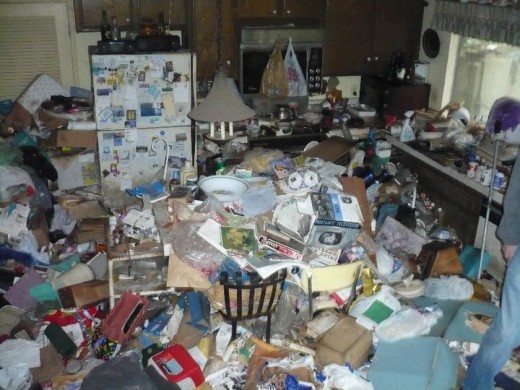- HubPages»
- Health»
- Mental Health»
- Emotions
A look into popular culture by examining Hoarders television show

Abnormal Psychology
Abnormal psychology is “the scientific study of problematic feelings, thoughts, and behaviors associated with mental disorders." The mental disorder examined below is compulsive hoarding. The American television series “Hoarders” gives insight into how serious of a disorder hoarding is. Using a television show from the series titled “Manuel and Carla”, hoarding behaviors and the course of treatment associated is examined in the paragraphs below.
Hoarding Behaviors
Hoarding is a complex disorder. It is thought to be associated with four fundamental characteristics. Randy Frost , a professor with the International OCD Foundation, explains that the first characteristic includes emotional dysregulation and high levels of perfectionism. Frost describes that the second characteristic deals with difficulty processing information. Problems with attention, categorization, memory, and decision making typically are present in those who hoard. The third underlying characteristic is that people who hoard develop intense emotional attachments to objects. “These attachments take the form of attaching human-like qualities to inanimate objects, feeling grief at the prospect of getting rid of objects, and deriving a sense of safety from being surrounded by possessions." The last characteristic includes the hoarders feeling like they cannot waste objects.
Compulsive hoarding is currently thought to be maintained by a “pattern of maladaptive beliefs, avoidant and impulsive behavior patterns, and cognitive impairments." Obsessive-compulsive disorder (OCD) is closely related to hoarding behaviors. Impulsive behaviors for instance, are part of both compulsive hoarding and OCD. Impulsive behavior is when people take action before thinking. People who act impulsively do things without thinking of the effect their actions might have on themselves and others. In terms of hoarding, people buy things or acquire things without considering if they have room at home. Their things start to accumulate, and they end up piling messes and cluttering the house before they realize it. They are unable to resist their impulses to buy things and hold on to worthless things, because to them, they have worth and a connection is developed.

There is Treatment
In the show, the two hoarders, Manuel and Carla, started working with a licensed clinical psychologist that specializes in hoarding, OCD, and anxiety disorders. In order to get better, it was determined that Carla needed to focus on herself. She was treating herself negatively, because of the mental image she had of herself. Carla wanted to get better, and she was ashamed at the conditions of her home. Manuel, on the other hand, was less willing to do what was needed. He had a hard time throwing the junk away, because he had developed a personal connection with it. The first step in treatment was to get the houses cleaned. After the houses were cleaned, both Manuel and Carla still needed to see a therapist and aftercare organizer to work on their disorder.
Individual treatment for compulsive hoarding includes a combination method. The three elements combined include “elements of motivational interviewing, skills training, and several features of cognitive therapy and behavioral practice for OCD." The behaviors that are the main focus for treatment are “difficulty discarding or letting go of possessions, excessive acquisition, and disorganization and clutter that impairs functioning." Group treatment is also available to help those who are compulsive hoarders. Treatment for hoarders is thought to be highly effective. In a study ten hoarders were treated with cognitive-behavior therapy using twenty-six sessions. Eight out of ten of the participants were found to be much improved after the therapy. In a later study, they used forty participants, and seventy-five percent were found to be much improved after the therapy.

Thoughts
I was appalled while watching the television show. Before watching, I was not aware that compulsive hoarding was an actual disorder. When showing the two people that were compulsive hoarders, the pictures and conditions were horrifying. One thing that stood out to me was that both hoarders were also not sanitary. Their houses were not only cluttered, but they were also dirty, infested with coach roaches and rats, and unsanitary. I expected the house to have a good amount of clutter, so that people could not walk through it, but I did not expect it to have bugs, mice, and rats.
Carla describes that she can hear mice running around and knocking things out of the cabinets. She mentioned that they squeak all night while she is trying to sleep. When talking about how she came to be the way she is, Carla explains that she hoards to make herself feel better because of all the pain she has had in her life. Shopping is something that she enjoys, but she ran out of room for all her stuff. Carla does not remember what her house used to look like and how it came to be such a mess. After three failed marriages in which she was abused, she got a new boyfriend who also abused her. She became severely depressed and then with each new stressor she experienced, the hoarding became worse and worse.
As recently mentioned, Manuel was not as willing to give up his stuff as Carla was. Manuel had a deep attachment to the objects he saved, and made excuses for why he could not get rid of some of them. For instance, he mentioned that the dishes belonged to his wife and that he could not get rid of them. When his wife was asked however, she said they needed to be thrown out. Once he realized the enormous impact his mental disorder was having on the entire family, he was able to step back and let the professionals help out.
Compulsive hoarding is a true mental disorder that has a far-reaching impact not only on the person with the disorder, but the entire family as well. It can be dangerous, as those living in the filth are subject to unsanitary and hazardous conditions. Treatment includes cleaning up the mess and then discussing the reason for the hoarding behaviors, along with cognitive-behavioral therapy. Hoarders must work on their impulse control, so that they can resist the urge to hold on to or buy unnecessary objects. Manuel and Carla from “Hoarders” are two great examples of truly compulsive hoarders, but with treatment, they were able to overcome their disorder.









